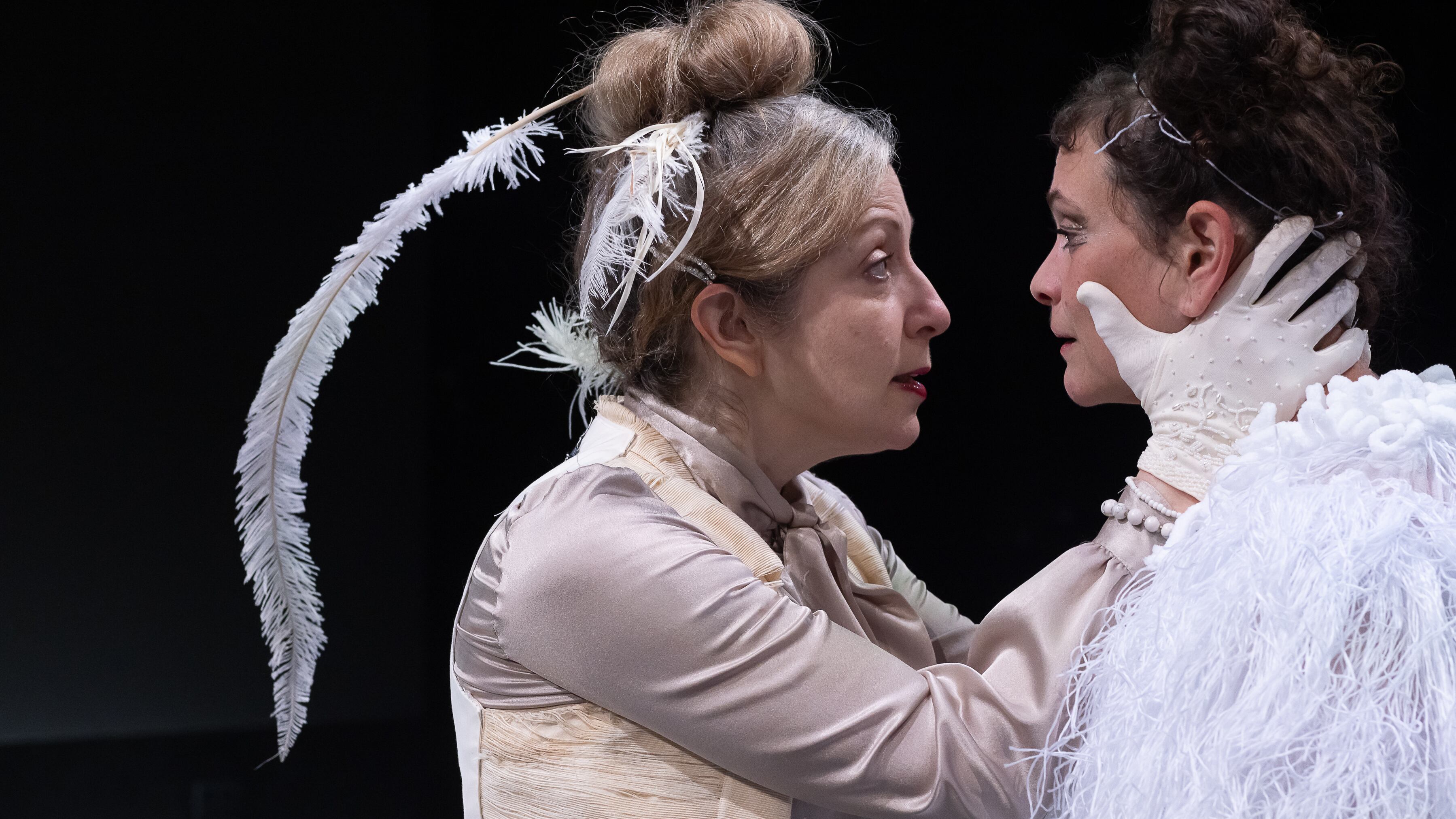A bicycle glides across the stage, white feathers float from the ceiling, and a group of people in Victorian costumes play bingo inside a giant wooden box.
These are just some of the delightfully off-kilter images—often accompanied by ambient music—packed within Portland Experimental Theatre Ensemble’s a seagull, its version of Anton Chekhov’s 1896 play The Seagull.
Premiering at Portland Center Stage’s Ellyn Bye Studio and directed by PETE co-founder Rebecca Lingafelter, the production is the culmination of the group’s 10-year Chekhov Project, a collaboration with translator Štěpán Šimek to create adaptations of four of the Russian writer’s plays. For a seagull, company member Chris Gonzalez took Šimek’s translation and created a text that turns Chekhov’s sad sacks into characters who express their emotions through muscular movement, often to comic effect.
At any point in the play, its actors may be running in circles, flapping their arms, or balancing in a yoga Warrior III pose—actions that, in the context of the story, suggest dissatisfaction, mostly stemming from unrequited love. Konstantin (Ken Yoshikawa) loves Nina (Amber Whitehall) and wants to be a writer. Nina wants to be an actor and get it on with the famous writer Trigorin (Jacob Coleman), who’s the lover of Konstantin’s mother, Arkadina (Maureen Porter). Meanwhile, Masha (Cristi Miles) loves Konstantin… and so on.
For a play based on such an elaborate setup, the show ironically begins on a bare stage, save for an old wooden ladder. As the production progresses, though, the imagery becomes more baroque, with magenta lighting and a field of stars twinkling on the curved backdrop. From there, the props also multiply, including everything from tarps and origami seagulls to a pile of snowy white packing peanuts.
Likewise, actors start out in utilitarian jumpsuits that gradually morph into fussy Victorian garb, while the crew is dressed in feathery seagull suits that eventually become the usual all-black attire worn by stagehands, a transformation that links to Lingafelter’s program note, which says the production is a “love letter to life of the theater behind the scenes.”
Along those lines, the program lists the names of the performers but not their characters. Who are we watching—the actors or the dramatis personae? At one point, Miles stops one of lovelorn Masha’s monologues to say that she herself is going through a divorce, and Yoshikawa, like Konstantin, is a playwright in real life.
The energetically stellar cast invites us to explore our own perceptions of theater and life, such as when Masha asks someone in the audience to take a swig of water and pretend it’s vodka, and Trigorin swans around in aviator sunglasses, striped tube socks and sleazy white dress shoes, suggesting he’s simply a minor and silly celebrity with a bloated ego. Later, he tells Nina he’s an average guy who’s not above eating a Denny’s Grand Slam breakfast and, in almost the same breath, casually refers to a New York Times story about himself, then admits he hasn’t really lived yet.
Just who is this guy, and how does his goofy mix of insecurity and arrogance fit with Chekhov’s maxim that every element in a play must have a specific purpose? Although the production doesn’t aim to offer anything as trite as a message, the implication is that people can feel the despair and still carry on…and maybe even have some fun along the way.
The show is so lushly woven with such ideas and antics, watching it is like wandering a hall of mirrors. In one scene, Dorn (Roo Welsh), a ladies man with a bad cough, circles the stage with the vapors of a fabric steamer aimed at his face, creating a surreal gesture that underscores the sadness of his ill health. At the same time, Masha (or is it Miles?) is doing vocal exercises, Konstantin is bickering with Arkadina, and stage hands are sweeping feathers off the floor.
Delving even deeper into theater life, we later see a projected image of Porter happily chatting backstage with Webb while changing into a sparkly minidress. The trippy illusion gets more mind-bending when the wall separating stage and backstage is opened and the audience simultaneously sees physical performers behind the scenes as well as their projected images. Konstantin says it best when he tells Nina he wants to create plays that make people wonder, “What the fuck just happened?”
PETE does that and then some. Like an expertly performed magic trick involving a box and a bird, the show’s intricate vision creates an enticing bafflement…and the pleasure of unpacking it in the theater and beyond.
SEE IT: Portland Experimental Theatre Ensemble’s a seagull plays at Portland Center Stage at the Armory, 128 NW 11th Ave., 971-258-2049, pcs.org. 7:30 pm Wednesday–Saturday, July 10-13. $25–$45. All ages.
